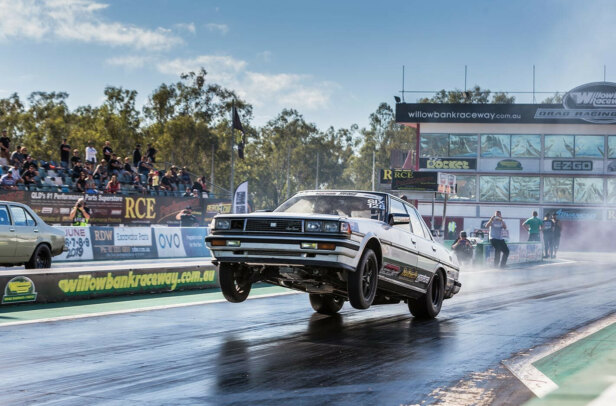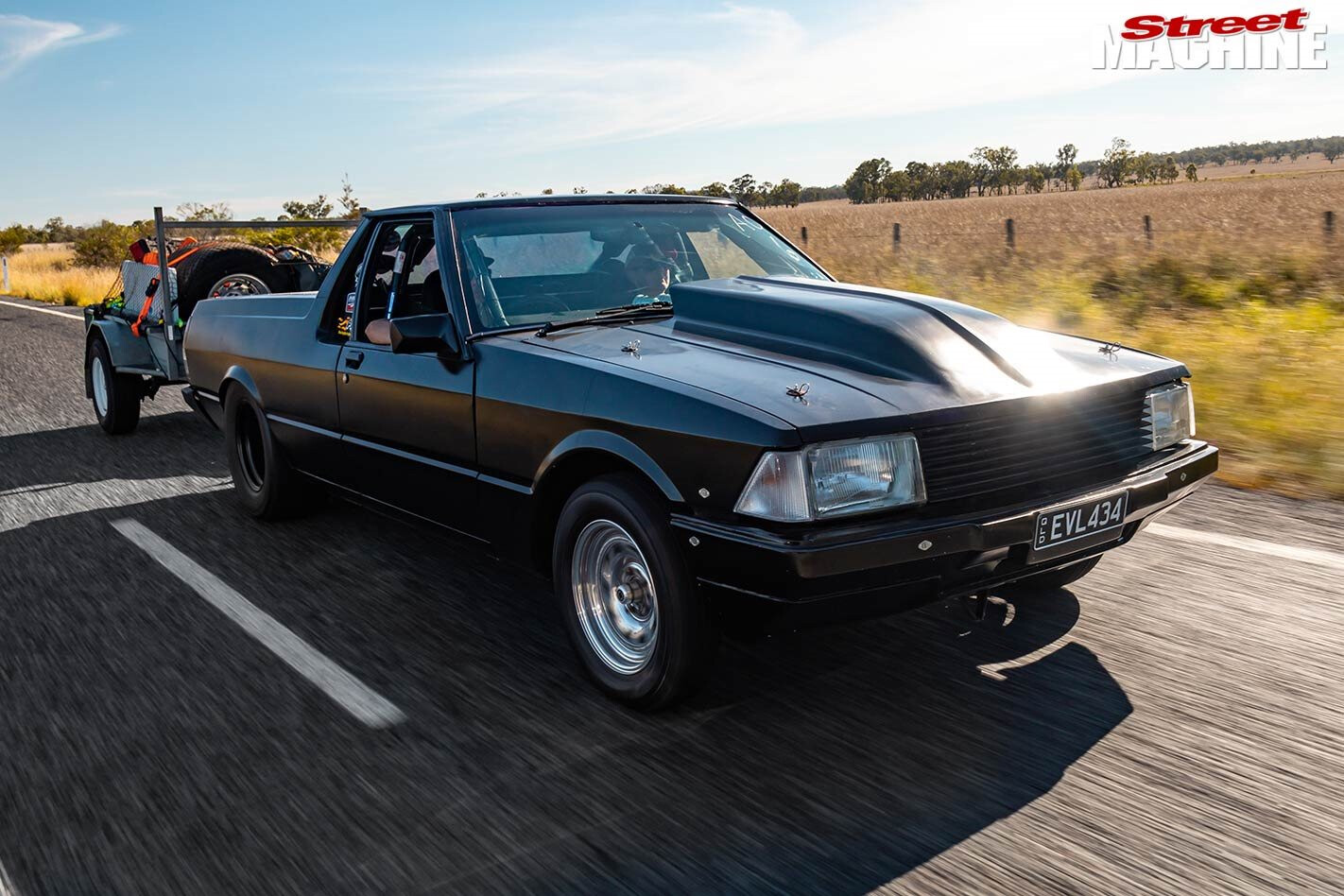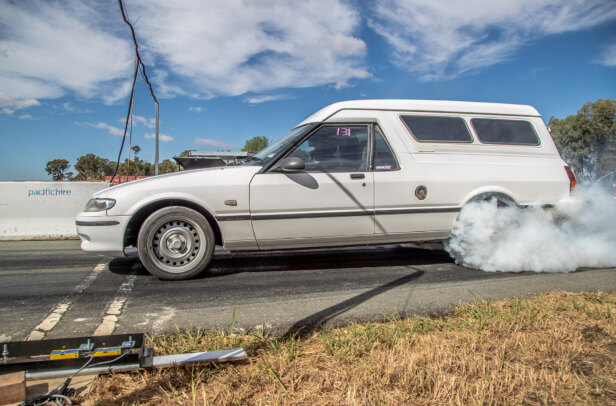WHEN it comes to preparing for Street Machine Drag Challenge, most punters concentrate on the task of getting their car down the standing 1320 in a rapid fashion without driving over their crank or rods. However, there is one aspect of DC events that catches out many newbies: maintenance and prep!
Working out what tools and spares to take with you should be a huge part of your pre-event preparation, along with properly kitting your car out for five road trips in a row and deciding which of your friends to take (and how many you cram in if you’ve got a small car like a Torana or Capri). Do you bring a trailer, or build a larger car that might chew more consumables?
To answer some of these questions, we sat down with YouTube personality Ben Neal from Benny’s Custom Works. He’s raced in the past two Drag Challenge Weekend events in Queensland (winning the Speed Pro Six-Cylinder Class in 2020), but also shipped his ’87 Toyota Cresta to the USA to complete Hot Rod Drag Week in 2018 and 2019.
“I use a 7x5x5 luggage trailer – like what you’d see hauling suitcases to an airport – to haul our spares, tools and luggage,” Ben says. “I think my experiences with American U-Haul trailers at Drag Week helped me work out what I wanted when it came time to set up this enclosed trailer for Drag Challenge back here.
“The biggest downfall of the U-Haul-style trailers is they don’t have side access, as I ended up constantly changing how we packed the trailer looking for a way to get easier access to the heavy spares you have to load up the front. And having that stuff at the front is important so you maintain perfect weight distribution and have good towing manners.”
While some would be tempted to pack a whole workshop’s worth of spares and tools to get through a week of drag racing and road-tripping, one of Benny’s biggest tips is to watch your trailer weight.
“I like to run 80-100kg nose weight on the trailer so it is always safe to tow,” he explains. “But that means you have to put the toolbox at the front, so trying to get tools to work on the car every day becomes a chore if you can’t open the side and get straight to them. I’d estimate my trailer is around the 700kg mark, and you really want to keep it under a tonne to avoid having trailer brakes.”
Some may peep Benny’s trailer and figure it was built with mythical YouTube money, but the spares-hauler is a golden example of doing a lot with a little. “I’d say I’m about $3000 into it, but you could do it cheaper by enclosing a box trailer yourself,” he says. “This was a Facebook Marketplace find, and for the most part the functionality was pretty good as it already had the side- and rear-opening doors. The guy had used it for landscaping, so it’d had a bit of a beating; most of what I’ve done has been aesthetic. I got it painted, changed the mudguards, mounted a toolbox to the front and made a racking system for my plastic tubs.”
Working out what he was going to need for a week of automotive shenanigans is how Benny started this project. “First-timers need to understand you really need to be self-sufficient on the road,” he says. “It’s good to get help from people, or offer it yourself, but if you decide to drive through the night, there won’t always be a lot of passing traffic to help you out.”
The possibility of having to pull your car to bits on the side of the road or in the pits was another reason for Benny preferring trailer life, as some entrants without one have had to spend hours unpacking their car to solve an issue or get ready to hit the lanes. “I can turn up and be in the lanes in five minutes, whereas some people do their servicing in the morning, so they’re an hour or more in before they’re ready to make a pass,” he says.
The two-time Drag Week veteran also suggests doing some test runs to make sure your car can handle the open-road load. “It won’t hurt to chuck your trailer on and go for a burn down the highway, even just to work out your fuel economy,” he says. “If you’re an E85 car, you’ll need to work out if you’ll be able to find E85, or have a strategy in place for what you’ll do if you can’t.”
Benny’s success at finishing these events both in Australia and America speaks for the strength of his packing plan, so take it from a bloke who’s been there and done that.
SLEEPING BEAUTIES
WORKING out where you’re going to park your head at the end of a long day is another thing newbies can forget to plan for. Do you stay near the track you just raced at, or do you make the journey to the next track, risking arriving late if you have dramas along the way?
The strategy for Benny and his crew has been to make one pass at the track and then hit the road. “The idea is to get on the road early to give yourself the most amount of time to sort out any potential problems that crop up before we have to get to the next track,” he says. “If you leave the next day and have a seven-hour unscheduled stop, that will really eat into your racing time.
“We normally set the car up the night before, including flushing the 98 RON fuel out for E85,” Benny continues. “I also change to race wheels and tyres, as the car doesn’t have any clearance issues with the crew and trailer – although I wouldn’t recommend driving on drag radials for any distance on the street. I’ve had a few sketchy moments in bad weather on radials in the USA; when you’re doing 100km/h with a trailer on the back and it gets greasy, that isn’t fun!”
CREATURE COMFORTS
DRAG Challenge really is an endurance event; even just being stuck inside a modified car for the best part of a week can take a physical toll on both driver and passengers. So while Benny loves a fast car, he also keeps an eye on occupant comfort.
“The Cresta weighs 3300lb with me in it at race weight,” he says. “All the Toyota sound-deadening is still there, but we’ve added a heap of thermal and acoustic insulation to make it nicer inside, and there is a lot of work done in the engine bay around exhaust temps, too.
“Dehydration is a big thing people forget about. Drinking water is really important, especially if you’re driving through the heat of the day – and avoid bad food. We don’t drink a lot of booze during the week either, because it can make the week harder than it already is.
“Having the Commspeed Race Car Radio headsets in America was great because it allowed us to have a conversation in the car but also made the trip quieter, which helps with fatigue; you don’t have that noise in your ears for hours at a time. That hammers you, so anything you can do to avoid noise is better.”
PREVENTATIVE MEDICINE
BENNY doesn’t have a set checklist for looking over the car before or during race-and-drive events. “I tend to keep an eye on the car and give it a quick check-over regularly so there are no surprises,” he explains. “Checking the wheel bearings, axles, brakes and the like is regular maintenance, and I will take notice of the health of all these areas while working on the car during regular track days, or in the course of working on it while we’re making upgrades or changes.”
When it comes time to perform maintenance on the road, Benny doesn’t go overboard. “Engine oil changes are more to do with the car sitting around, because the car builds up a lot of moisture in the oil from the E85, especially from just moving it in and out of the shop,” he says. “We’ll change oil every second day at Drag Challenge just because, as I have a mantra that ‘oil is cheaper than engines’.
“We change plugs all the time during the week, and we carry 20L of fresh transmission fluid as it isn’t a regular off-the-shelf oil. We don’t find the Cresta wears parts out all that much, but we keep an eye on how the car is performing and use our datalogging system to do quick health checks on the road.”
Electrical gremlins are one of the most common issues facing Drag Challenge entrants, as the cars cop an absolute belting on rough Aussie highways. EFI cars like Benny’s Cresta live and die by their electrical systems, so he brings different gauges of fresh wire, spare Deutsch connectors, wire strippers, a soldering iron, solder and heat shrink. He also packs a whole raft of spare sensors for the engine combo, in case one wigs out randomly on the road
“The spares I’d take are general consumables like sparkplugs, accessory belts, a water pump, power steering pump, alternator and a starter motor,” Benny says. “If it’s a carby car, I’d take a spare carb and tuning kit, and I carry spare fuel pumps for EFI. I’ve also got spare AN line service parts, too; different hoses and fittings are important”
“We have a quick-grab kit that includes most of our power tools, and we run our jack and chassis stands at the back so they’re easy to grab,” Benny says. “I split the trailer down the middle with a foldable table; all our fuel runs on the right-hand side, while the left side has our wheels, the jack and stands, and the gear bag. This makes it easy to change a wheel on the side of the road or change the car over in the pits in the morning
“We run what I call an apprentice tool kit, which we added a few extra tools to. Before you go on Drag Challenge, work with the tool kit you’ll bring with you. When we built the Mustang in the USA, we worked out of our road kit so we knew exactly what tools we needed and what we had to add to the kit as we went.
We also worked out what tools needed to be modified, like the 11mm spanners to get around the exhaust manifold, before we were in the middle of nowhere on the road”
Benny is very aware that sometimes the simplest component can knock a car out of Drag Challenge. “Because we’re an EFI car and run a standalone Haltech ECU, I also take spare sensors for the engine, including MAP, oil pressure, cam and crank angle, and even ignition coils,” he says
“We’ve got suspended storage down the centre of the trailer for plastic tubs that I can slide in and out, which hold smaller items,” Benny explains. “Plus I have a rack to slide my pit tent in for shade, too. I priority-pack the tub rack so we don’t have to pull five of them out to get to the one we always need most. This is why the back tub has our roadside assistance stuff like magnetic torches and high-vis vests”
With E85 sometimes being hard to source, Benny keeps six jerry cans full of the fresh boost juice in the trailer. “I try to keep 25L containers there, but they can be hard to find compared to 20L jugs. Watch out for American jerry cans with their crazy restrictors in the neck; we had to gut ours so we could pour fuel easily”
“One hot tip I can give people is to take nappy rash cream and baby wipes to avoid bum chafe in the kind of horrible humid weather you get at Drag Week,” Benny laughs. “People always forget things like a laptop charger, first aid kit, gloves for working on a hot car and sunscreen. I also make sure I have a tray of new nuts and bolts for things that might rattle loose. Coil-over spanners and AN spanners are a great idea to chuck into your toolbox, and you really need to have a working speedo and trip meter for navigating route directions”
“I’d definitely recommend beefing up your trans cooler before going on Drag Challenge, and potentially adding a second one,” Benny says. “You should have a gauge, even if it is through your ECU, to keep an eye on trans temps”
“Going to America, there is one downside to being an international tourist: most foreigners will have to haul their travel luggage, too. When we went over in 2019 and built Ben Paganoni’s Fox-body Mustang, we were over there for five weeks, so we negotiated with our accommodation to leave some bags behind so we only had to take a week’s worth of luggage on Drag Week”




Comments